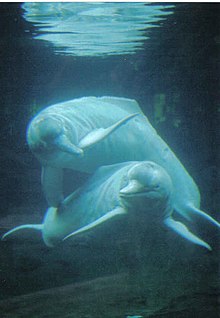Amazon river dolphin
| Amazon River Dolphin | |
|---|---|

| |
| An Amazon River Dolphin at Duisburg Zoo. | |

| |
| Size comparison against an average human | |
| Scientific classification | |
| Kingdom: | |
| Phylum: | |
| Class: | |
| Subclass: | |
| Order: | |
| Suborder: | |
| Superfamily: | |
| Family: | Iniidae Gray, 1846
|
| Genus: | Inia
|
| Species: | I. geoffrensis
|
| Binomial name | |
| Inia geoffrensis Blainville, 1817
| |

| |
| Amazon River Dolphin range | |
The Amazon River Dolphin, alternately Bufeo or Bufeo Colorado (both in Peru), Boto, Boutu, Nay, or Pink River Dolphin[1] (Inia geoffrensis) is a freshwater river dolphin endemic to the Orinoco, Amazon and Araguaia/Tocantins River systems. The largest of the river dolphins, this species is not to be confused with the Tucuxi (Sotalia fluviatilis), whose range overlaps that of the Amazon River Dolphin but is not a true river dolphin. The neck vertebrae of the Amazon River Dolphin are not fused together, and therefore the Boto is able to bend its neck in a 90 degree angle to its body, and skillfully hunt fishes in the flooded forest.
The IUCN lists various other names to describe this species including Amazon Dolphin, Boto Vermelho, Boto Cor-de-Rosa, Bouto, Bufeo, Dauphin de l'Amazone, Inia, Pink Dolphin, Wee Quacker, Pink Freshwater Dolphin, Pink Porpoise, Encantado, and Tonina.
Taxonomy
The species was described by Henri Marie Ducrotay de Blainville in 1817.
1998 classification lists a single species, I. geoffrensis, in the genus Inia, with three recognized subspecies:
- I.g. geoffrensis - Amazon and Araguaia/Tocantins basin population (excluding Madeira River drainage area, upstream of the Teotonio Rapids in Rondonia)
- I.g. boliviensis - Amazon basin (Bolivian sub-basin) population in the Madeira drainage area in Bolivia upstream of the Teotonio Rapids
- I.g. humboldtiana - Orinoco basin population
Some older classifications listed the boliviensis population as a separate species.
Mythology
In a traditional Amazon River myth, at night an Amazon River Dolphin becomes a handsome young man who seduces girls [2], impregnates them, then returns to the river in the morning to become an Amazon River Dolphin again. This dolphin shapeshifter is called an encantado. It has been suggested that the myth arose partly because dolphin genitalia bear a resemblance to that of humans.[citation needed] In the local area, there are also tales that it is bad luck to kill an Amazon River Dolphin. Legend also states that if a person makes eye contact with an Amazon River Dolphin, that person will have nightmares for the rest of his or her life.
Associated with these legends is a culture of use of various fetishes such as for example dried eyeballs and genitalia. The use of these fetishes may or may not be accompanied by the intervention of a priest. Although sold as boto objects, a recent study has shown that despite the claim of the seller and the belief of the buyers, none of these fetishes are derived from the boto. They are derived from Sotalia guianensis, are most likely harvested along the coast and the Amazon River delta, and then are traded up the Amazon River. In inland cities that are far from the coast, many if not most of the fetishes are derived from domestic animals such as sheep and pigs [3].

The 1987 Brazilian film Ele, o Boto is a supernatural romance featuring an Amazon River Dolphin who has a son by a young woman.
Food and diet
The Amazon River Dolphin has 25-30 peg-like front teeth for catching prey and it mainly eats crustaceans, crabs, turtles, catfish and other fish.
References
- ^ "Wildfacts: Boto". BBC. Retrieved 2007-02-21.
- ^ "Whales and Dolphins" at ancientspiral.com
- ^ Gravena, W., T. Hrbek, V.M.F. da Silva, and I.P. Farias (2008). "Amazon River dolphin love fetishes: From folklore to molecular forensics". Marine Mammal Science. 24: 969–978. doi:10.1111/j.1748-7692.2008.00237.x.
{{cite journal}}: CS1 maint: multiple names: authors list (link)
- General references
- Template:IUCN2006 Database entry includes a lengthy justification of why this species is vulnerable.
- Rice, Dale W. (1998). Marine mammals of the world: systematics and distribution. Society of Marine Mammalogy Special Publication Number 4. 231 pp.
- Montgomery, Sy (2000). Journey of the pink dolphins : an Amazon quest. Simon & Schuster, 317 pages. 068484558X
- Juliet Clutton-Brock (2000). Mammals, 381 pages.
- Hilda. "Pink Dolphin". Retrieved 2007-09-08.
External links
- Book: "Pink dolphin, friend of the river" (Web Site - English & Spanish)
- Omacha Foundation - A non-government and non-profit organisation, created to study, research and protect river dolphins and other fauna and aquatic ecosystems in Colombia (website in English and Spanish). Winner of the 2007 Whitley Awards (UK)
- Projeto Boto - a non-profit research project that is increasing knowledge, understanding and the conservation prospects of the Amazon's two endemic dolphins - the Amazon River Dolphin (Inia geoffrensis) and the tucuxi (Sotalia fluviatilis)
- Dolphins, Whales and Porpoises: 2002–2010 Conservation Action Plan for the World's Cetaceans. IUCN/SSC Cetacean Specialist Group 2003, Reeves et al. HTML copy of book-length report
- Convention on Migratory Species page on the Amazon Dolphin
- The Nature Conservancy works to protect habitat for the Amazon River Dolphin
- Walker's Mammals of the World Online - Amazon Dolphins
- Animal Info page on the Amazon River Dolphin
- - Virtual Explorers
- Whale & Dolphin Conservation Society (WDCS)
- [1]
- - The Motorcycle Diaries Script

